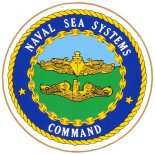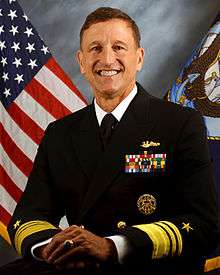Naval Sea Systems Command


The Naval Sea Systems Command (NAVSEA) is the largest of the United States Navy's five "systems commands," or materiel (not to be confused with "material") organizations. NAVSEA consists of four shipyards, nine "warfare centers" (two undersea and seven surface), four major shipbuilding locations and the NAVSEA headquarters, located at the Washington Navy Yard, in Washington D.C.
NAVSEA's primary objective is to engineer, build, and support the U.S. Navy's fleet of ships and its combat systems. NAVSEA accounts for one quarter of the Navy's entire budget, with more than 150 acquisition programs under its oversight.
The other Navy systems commands are:[1]
- Naval Air Systems Command (NAVAIR)
- Space and Naval Warfare Systems Command (SPAWAR)
- Naval Facilities Engineering Command (NAVFAC)
- Naval Supply Systems Command (NAVSUP)
History
The origin of NAVSEA dates to 1794, when Commodore John Barry was charged to oversee the construction of a 44-gun frigate and ensure that all business "harmonized and conformed" to the public's interest.[2] Since then various organizations were established and succeeded them to oversee design, construction and repair of ships and ordnance.
Established in 1940, Bureau of Ships (BuShips) succeeded the Bureau of Construction and Repair, which had been responsible for ship design and construction, and the Bureau of Engineering, which had been responsible for propulsion systems. These bureaus traced their origins back to earlier organizations.
The Naval Ship Systems Command was established in 1966 replacing BuShips.
The Naval Sea Systems Command was established on July 1, 1974 with the merger of the Naval Ship Systems Command (NAVSHIPS) with the Naval Ordnance Systems Command (NAVORD). NAVORD was the successor to the Bureau of Naval Weapons and the earlier Bureau of Ordnance.
Facilities
The current NAVSEA facilities are:
- Puget Sound Naval Shipyard – Bremerton, Washington
- Norfolk Naval Shipyard – Portsmouth, Virginia
- Portsmouth Naval Shipyard – Kittery, Maine
- Pearl Harbor Naval Shipyard – Hawaii
- Naval Surface Warfare Center
- Dahlgren – Dahlgren, Virginia
- Crane – Crane, Indiana
- Carderock – Carderock, Maryland
- Indian Head – Charles County, Maryland
- Port Hueneme – Port Hueneme, California
- Corona – Norco, California
- Panama City – Panama City, Florida
- Dam Neck Combat Direction Systems Activity – Virginia Beach, VA
- EOD Technology Division – Stump Neck, Charles County, Maryland
- Philadelphia – Philadelphia, Pennsylvania[3]
- Naval Undersea Warfare Center
- Naval Undersea Warfare Center – Newport, Rhode Island
- Naval Undersea Warfare Center Keyport Division[4] – Keyport, Washington
- Washington Navy Yard – Washington D.C.
- Allegany Ballistics Laboratory – Rocket Center, West Virginia
- Supervisors of Shipbuilding[5]
- SUPSHIP Bath – Bath, Maine
- SUPSHIP Groton – Groton, Connecticut
- SUPSHIP Gulf Coast – Pascagoula, Mississippi
- SUPSHIP Newport News – Newport News, Virginia
- Naval Sea Logistics Center
Program Executive Officers (PEO)
NAVSEA's five affiliated Program Executive Offices (PEOs) are responsible for all aspects of life-cycle management of their assigned programs. PEOs report to the NAVSEA commander for planning and execution of in-service support, and to the Assistant Secretary of the Navy (Research, Development and Acquisition) for acquisition-related matters.[6]
The NAVSEA affiliated PEOs are:
- Program Executive Officer, Aircraft Carriers (PEO Carriers)
- Program Executive Officer, Integrated Warfare Systems (PEO IWS)
- Program Executive Officer, Littoral Combat Ship (PEO LCS)
- Program Executive Officer, Ships (PEO Ships)
- Program Executive Officer, Submarines (PEO Subs)
Current Commander

Vice Adm. William H. Hilarides became the 43rd Commander of NAVSEA on June 7, 2013.[7]
Rear Admiral Thomas J. Kearney is the current Vice Commander of NAVSEA.[8] William J. Deligne is currently the Executive Director.[9]
2013 shooting
On Monday, September 16, 2013, a 34-year-old former U.S. Navy veteran and current IT contractor, identified as Aaron Alexis, gained access to the Navy Yard using a valid ID card,[10] entered Building 197, and opened fire with a sawed-off shotgun and a stolen handgun, killing twelve people and wounding three others, including a D.C. police officer. Alexis was killed after engaging in a shootout with responding police.
References
- ↑ "About NAVSEA". NAVSEA.
- ↑ "About NAVSEA". NAVSEA.
- ↑ "NSWC Philadelphia".
- ↑ "NUWC Keyport". NAVSEA. Retrieved 13 April 2016.
- ↑ "Supervisor of Shipbuilding, Conversion & Repair". Navsea.navy.mil. 2007-11-26. Retrieved 2013-09-16.
- ↑ "About NAVSEA". NAVSEA.
- ↑ http://www.navy.mil/navydata/bios/navybio.asp?bioID=319
- ↑ http://www.navy.mil/navydata/bios/navybio.asp?bioID=713
- ↑ http://www.public.navy.mil/donhr/executivemanagement/aboutseniorexecutives/Bios/Deligne,%20W.pdf
- ↑ "Aaron Alexis' mother: 'My heart is broken' over Navy Yard shooting". CNN. Retrieved 18 September 2013.
External links
- Official website
- National Archives – Records of the Bureau of Ships (NAVSEA's predecessor organization)
